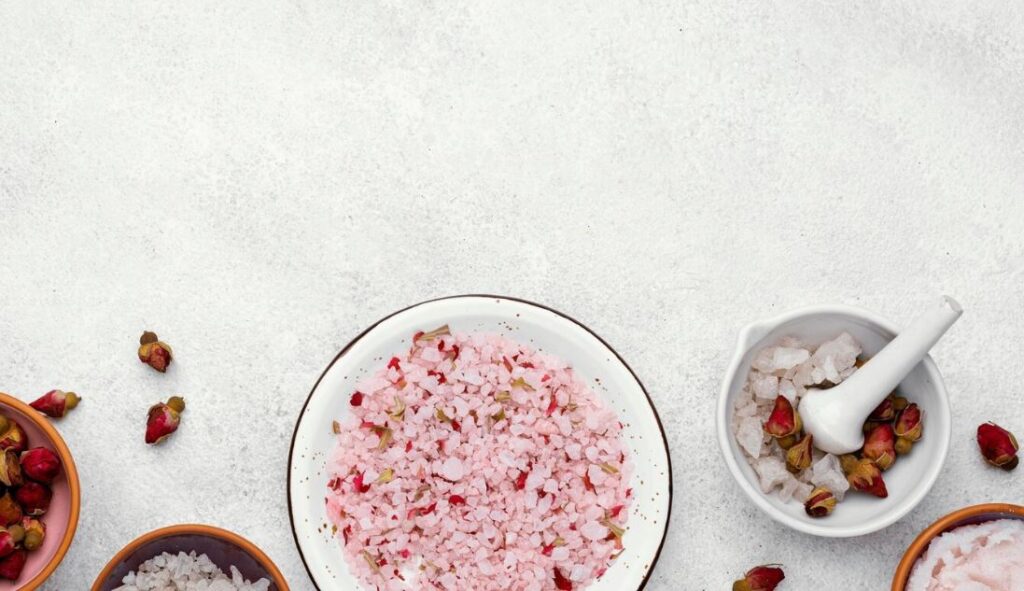
Every few months, a new wellness ritual that promises a quick route to feeling lighter, leaner, and somehow holistically healed starts making the rounds on social media. One beverage in particular has recently sparked a great deal of interest: a pinch of pink Himalayan salt mixed with a glass of cold water and occasionally flavored with lemon or honey. This early-morning tonic, known as the “pink salt trick,” has captured the attention of wellness bloggers, influencers, and even working mothers who are looking for a healthy start to a hectic morning.
This pink salt drink, which is widely referred to as “natural Mounjaro,” a reference to the prescription medication that is promoted for weight loss, seems like a more approachable substitute. Fundamentally, the recipe is incredibly straightforward; it might have been adapted from a mountaintop retreat or a grandmother’s notebook. However, its current identity has been shaped by the internet, where health claims spread more quickly than accurate information. Pink salt water has transformed from a habit of staying hydrated to a representation of clean living and metabolic awakening thanks to these digital whispers.
What Is The Pink Salt Recipe For Weight Loss?
| Feature | Details |
|---|---|
| Recipe Name | Pink Salt Trick / Sole Water |
| Main Ingredient | Pink Himalayan Salt (approx. 1/16 teaspoon) |
| Supporting Ingredients | 8–12 oz cold water, optional lemon juice, optional honey or pure maple syrup |
| Time of Consumption | Early morning on an empty stomach |
| Primary Claims | Hydration support, digestion aid, metabolism boost, electrolyte balance |
| Scientific Support | No peer-reviewed backing for weight loss effect |
| Medical Warnings | Not recommended for those with high blood pressure, kidney issues, or sodium-restricted diets |
| Trend Origins | Viral wellness communities, TikTok routines, detox-focused social media circles |
| Associated Buzzwords | “Natural Mounjaro,” “electrolyte hydration,” “sole water,” “morning detox elixir” |
The routine itself is what attracts people, not just the concept of a gentle detox. It goes beyond simply staying hydrated when you pour cold water, measure out a small pinch of mineral-rich salt, and take a slow sip before the sun rises. It’s an invitation to wellness and a mindful pause before the day demands everything else. The desire to create rituals that feel both traditional and useful is growing, especially among young women, and this one fits the bill.
More than 80 trace minerals can be found in pink Himalayan salt, which is extracted from the Khewra Salt Mine in Pakistan. These nutrients—which, understandably, have come to be shortened to “good for you”—in small amounts include potassium, calcium, iron, and magnesium. That sounds convincing. Influencers and blogs frequently emphasize the benefits of potassium for easing muscle cramps or exhaustion, calcium for bone health, and magnesium for calming nerves and balancing hormones.
The problem is that pink salt contains such trace amounts of these minerals that their nutritional value may be insignificant. According to Texas Tech University nutrition professor Dr. Allison Childress, the salt’s sodium content is much more noticeable than its trace advantages. Adding more sodium, even in ritual form, could be detrimental for most people who already consume more than the recommended daily intake. Overconsumption of sodium can cause swelling, water retention, and eventually elevated blood pressure, especially in people with underlying medical conditions.
Fans of pink salt still claim to feel “lighter” or “less bloated” after consuming the beverage, despite these reservations. Drinking more water could be the simple cause of that. It has been demonstrated that hydration itself promotes metabolism and reduces appetite. Water consumption first thing in the morning can help clear your digestive tract, eliminate toxins, and stop the kind of mindless snacking that frequently follows exhaustion.
This recipe allows for subtle personal adjustments and is incredibly versatile. Some people mix in raw honey or maple syrup for a hint of sweetness, while others add lemon for its sharpness and vitamin C. A dash of apple cider vinegar or a pinch of cayenne are added for those who want to experiment. Personalization is becoming more and more important in wellness routines, and this drink perfectly satisfies that need.
In fitness circles, it has also become a mainstay. A slight increase in sodium may actually help athletes or workers who perspire a lot by replacing electrolytes that are lost. In that case, the pink salt trick is a performance recovery technique rather than a weight loss aid. It is especially helpful for maintaining energy and avoiding cramps because it replenishes what is lost through exertion.
Many people search for options that are surprisingly accessible and reasonably priced during this larger wellness movement. Pink salt has an almost limitless shelf life and is available at almost every supermarket. It’s low-tech and incredibly dependable in contrast to celebrity-endorsed protein powders, supplement subscriptions, or designer detox kits. Its allure is increased by this contrast—luxury disguised as minimalism.
Naturally, not everyone has responded favorably to the trend. Specialists like New Jersey bariatric surgeon Dr. Hans Schmidt are still vital. He points out that a teaspoon of mineral salt cannot affect metabolism because it is far too complex. He goes on to say that the only way to lose weight is to establish a long-term calorie deficit through exercise and mindful eating.
Nevertheless, there is no indication that the public’s interest in “natural hacks” will diminish. Every trend, from castor oil packs to lemon water, from celery juice to chlorophyll drops, seems to speak to a deeper need for control in a chaotic time. That sense of agency is provided by the pink salt beverage. It’s a modest, personal choice that supports more general health goals.
People feel empowered when they incorporate wellness into their daily lives through consistent, symbolic action. The emotional reward is genuine, regardless of whether the benefits are supported by science. Particularly when shared publicly online, it promotes identity, routine, and discipline. As a result, the morning pink salt ritual has evolved from a beverage to a symbol of wellbeing.
However, there are noticeably better ways to go if losing weight is the primary goal. Research has shown that regular strength training, aerobic exercise, eating meals high in protein, and staying hydrated are all very effective. When used as prescribed, even new medications like Zepbound or Wegovy have produced noticeably quicker outcomes in clinical settings, with some trials showing a 20% or more reduction in body weight.
In the end, the recipe for pink salt is not a miracle. However, its ascent provides a startlingly transparent glimpse into our societal perspective. We yearn for simplicity. We yearn for connection—to the natural world, to customs, to reassuring routines. Therefore, if this ritual is performed with awareness rather than expectation, it may subtly enhance established techniques rather than replace them.
